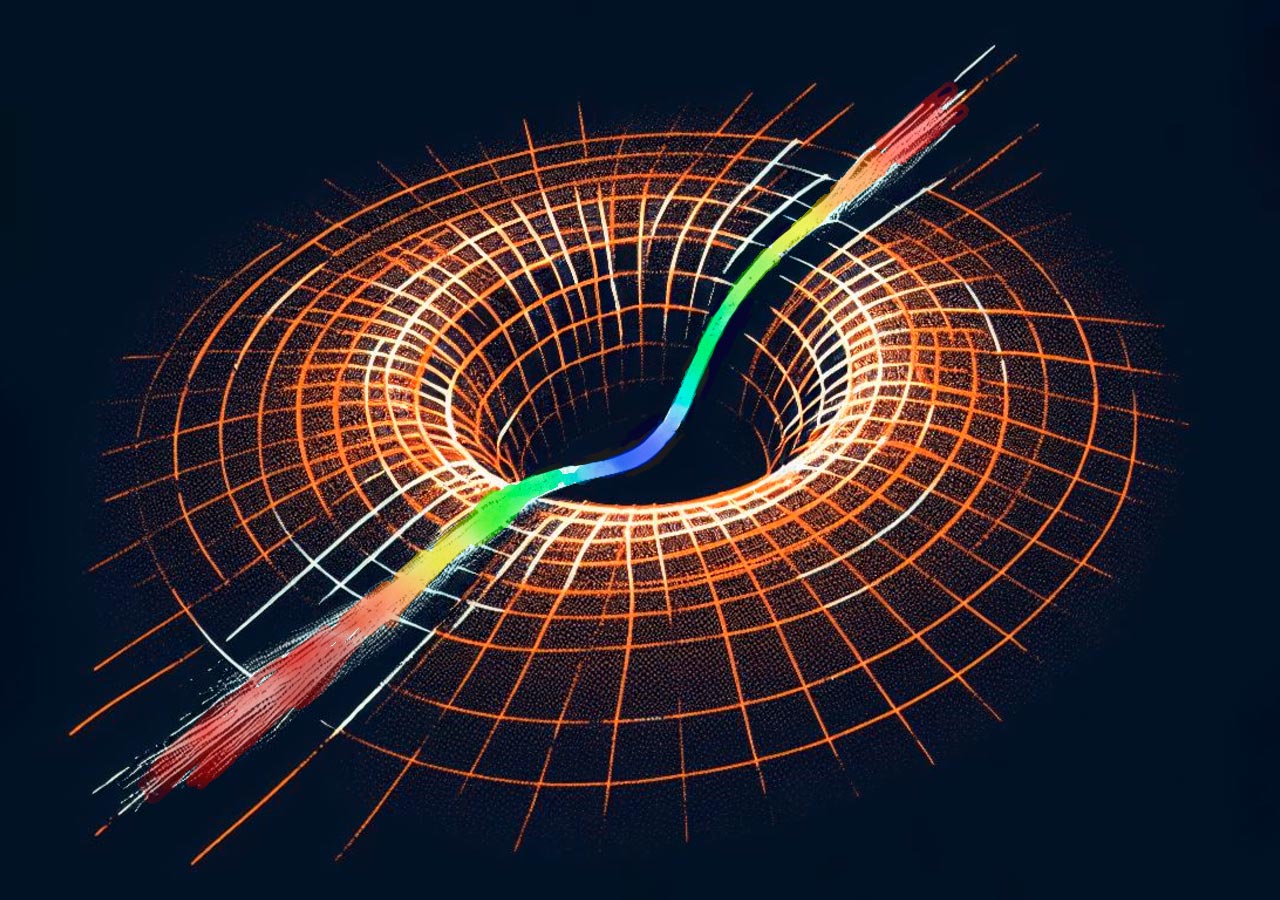
An artistic depiction of a wave encountering an exponentially curved spacetime. Credit: Matias Koivurova, University of Eastern Finland
Researchers Discover New Wave Equation Linking Wave Mechanics with General Theory of Relativity and the Arrow of Time
Scientists at Tampere University and the University of Eastern Finland have achieved a significant breakthrough with the derivation of a new wave equation that applies to accelerating waves. This novel equation not only sheds light on wave mechanics but also establishes connections between accelerating waves, the general theory of relativity, and the concept of the arrow of time.
Light-Matter Interaction Explored
One commonly observed phenomenon is that light appears to slow down when it interacts with matter. While standard wave mechanics can explain most of these occurrences, there has been a missing piece in the puzzle.
When light encounters an interface, the standard wave equation is satisfied on both sides. To solve this problem analytically, one must determine the characteristics of the wave on each side of the interface and then apply electromagnetic boundary conditions to connect them. However, the incident light must experience acceleration at the boundary, which has not been accounted for until now.
“Initially, I derived the standard wave equation in 1+1 dimensions assuming the speed of the wave is constant. Then it struck me: what if it’s not always constant? This turned out to be a very intriguing question,” explains Assistant Professor Matias Koivurova from the University of Eastern Finland.
By considering the possibility of varying wave speed, the researchers were able to develop what they refer to as an accelerating wave equation. While formulating the equation was relatively straightforward, solving it posed a new challenge.
“The solutions didn’t seem to make sense at first. Then it hit me that they exhibit behavior reminiscent of relativistic effects,” Koivurova recalls.
In collaboration with the Theoretical Optics and Photonics group led by Associate Professor Marco Ornigotti from Tampere University, the researchers eventually made progress. They discovered that to obtain expected solutions, a constant reference speed was necessary—the speed of light in a vacuum. According to Koivurova, everything started falling into place once they realized this fact. Subsequently, they explored the profound implications of this formalism.
The Arrow of Time Revealed
In a groundbreaking result, the researchers demonstrated that accelerating waves have a defined direction of time, often referred to as the “arrow of time.” This direction arises from the accelerating wave equation, which only allows for solutions where time progresses forward and never backward.
“Typically, the direction of time is derived from thermodynamics, where increasing entropy indicates the flow of time,” explains Koivurova.
However, if time were to reverse, entropy would decrease until the system reaches its lowest entropy state, followed by an increase in entropy again.
This difference between macroscopic and microscopic arrows of time lies in the fact that entropy unambiguously determines the direction of time for larger systems, while no such fix exists for individual particles.
“Yet, we expect individual particles to behave as if they have a fixed direction of time!” asserts Koivurova.
Since the accelerating wave equation can be derived from geometrical considerations, it becomes applicable to all wave behavior in the world. Consequently, a fixed direction of time emerges as a general property of nature.
Resolving the Abraham–Minkowski Controversy
Additionally, the framework enables analytical modeling of waves that are continuous everywhere, even at interfaces. This has important implications for the conservation of energy and momentum.
“There’s a well-known physics debate known as the Abraham–Minkowski controversy. The crux of the matter lies in determining what happens to the momentum of light when it enters a medium. Minkowski argued that momentum increases, while Abraham believed it decreases,” explains Ornigotti.
Experimental evidence has been presented in support of both perspectives.
“Our study demonstrates that, from the wave’s standpoint, the momentum remains unchanged. In other words, the momentum of the wave is conserved,” states Koivurova.
Relativistic effects account for the conservation of momentum. “We discovered that the wave experiences a proper time, akin to the concept in the general theory of relativity,” adds Ornigotti.
As the wave encounters a different time compared to that in the laboratory, the researchers identified that accelerating waves also undergo time dilation and length contraction. Koivurova highlights that it is precisely this length contraction that creates the illusion of non-conservation of momentum within a material medium.
Applications of the New Framework
Although the new formulation is equivalent to the standard approach in most scenarios, it delivers a valuable extension concerning time-varying materials. Inside these materials, light experiences sudden and uniform changes in material properties. The waves in such materials do not abide by the standard wave equation.
Here’s where the accelerating wave equation comes into play. It enables researchers to analytically model situations that were previously only accessible through numerical simulations.
One such scenario involves a hypothetical material called a disordered photonic time crystal. Recent theoretical investigations have demonstrated that a wave propagating within this material would exponentially slow down while exponentially increasing in energy.
“Our formalism reveals that the observed change in pulse energy is due to the curved space-time the pulse encounters. In these cases, local violation of energy conservation occurs,” explains Ornigotti.
This research carries wide-ranging implications, from explaining everyday optical effects to facilitating laboratory tests of the general theory of relativity. Furthermore, it offers insight into the existence of a preferred direction of time.
Reference: “Time-varying media, relativity, and the arrow of time” by Matias Koivurova, Charles W. Robson, and Marco Ornigotti, 19 October 2023, Optica.
DOI: 10.1364/OPTICA.494630


